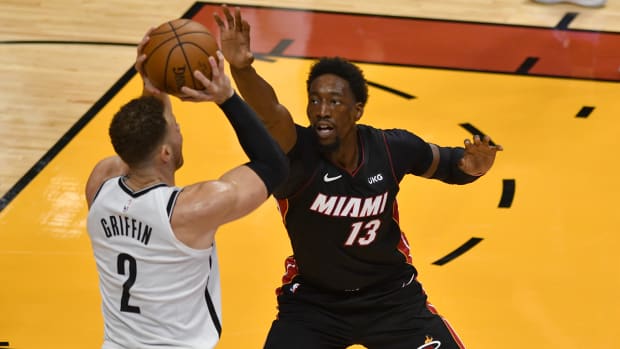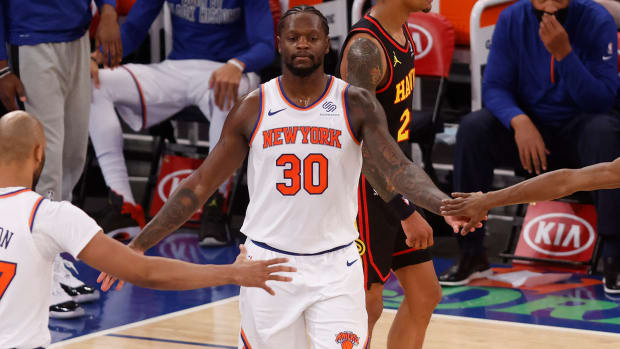Adebayo won’t win Defensive Player of the Year, but it’s perfectly fine to think he’s the best defender in the NBA
Welcome to the Morning Shootaround, where every weekday you’ll get a fresh, topical column from one of SI.com’s NBA writers: Howard Beck on Mondays, Chris Mannix on Tuesdays, Michael Pina on Wednesdays, Chris Herring on Thursdays and Rohan Nadkarni on Fridays.
Last year, at the age of 22, Bam Adebayo made his first All-Star team, was an eyelash away from winning Most Improved Player and ended his season as the second-best player on a Finals runner-up.
All he’s done in 2021 is get even better while hoarding more responsibility on both sides of the ball for a team no contender wants to face in the playoffs. But for whatever reason—be it his missing the All-Star game despite having a strong enough case to qualify, or the Miami Heat’s 24th-ranked offense and understandable-yet-frustrating struggle through a pandemic-ravaged regular season (after having a shorter mental and physical break than every other team in the conference)—his growth hasn’t felt nearly as noteworthy as it is.
Almost every time he steps on the court, Adebayo looks like a slightly more voracious version of the player you last saw. And while most upgrades are easier to spot on offense, there’ve also been tangible developments on the other end, where Adebayo unlocks one of the most versatile and rabid defenses in the NBA.
This article was not intended to argue for Defensive Player of the Year on Adebayo’s behalf (Rudy Gobert is a heavy favorite to win his third trophy). But, at the same time, it’s impossible to say with 100% certainty or confidence that anyone else is more complete on that side of the ball. Adebayo simply doesn’t surface as often as he should in these debates, so, in the spirit of highlighting one of this season’s most overlooked and distinct individual efforts, here is that very argument!
There are plenty of metrics that support Adebayo’s case (he’s third in defensive real plus-minus, and the Heat have the fourth-best defense in the league when he's on the floor), but a vote for Bam is more a vote for breadth and aesthetic singularity. How many defenders can and do switch on every possession no matter who has the ball without ever getting cooked? At the same time, he’s also wide and smooth enough to glide across the paint and single-handedly convince whoever’s trying to score that passing the ball might be the smarter play. Bam rebounds. Bam is quick and proactive, and when he switches onto you, it feels like a punishment.

When comparing a lockdown wing (Ben Simmons) and a stout rim protector (Gobert) in disputes over who deserves Defensive Player of the Year, it’s hard to isolate their respective responsibilities and say which archetype has the most value. Adebayo is closer to a prototype, both categories wrapped in one package.
Defensive Player of the Year is usually not awarded to who you’d most want on the ball in a tie game with 15 seconds left in Game 7 of the NBA Finals, but that specific element should be embraced more than it is. My choice for that hypothetical—or even just any one defender to be on my team in a must-win game—is Adebayo, who’s capable of having as much success on Nikola Jokić as Paul George, Damian Lillard or Zion Williamson. You can count on one hand the number of human beings who can say the same, if there are any.
As an anchor, the way he lets Erik Spoelstra explore the outer limits of his own creativity is a remarkable advantage. How many big men can function in a three-fourths court press that then falls into a 2–3 zone? How many can switch, drop and then blitz on three consecutive possessions without skipping a beat? Adebayo dominates entire possessions in more ways than anybody else. He allows his team to execute different schemes on the fly without hesitation—adaptability at its finest, a chaos agent who thrives inside the game’s rapidly expanding randomness.
Last year, Spo was applauded for his patience with Adebayo, a willingness to let him loose with the ball in his hands and work through growing pains. It was obviously worthwhile—like suffering through a paper cut in exchange for a winning lottery ticket. That leeway occurred on defense, too. But this year it’s been far more intense, with Adebayo spending nearly all his minutes at the five, seeing his identity grow more and more congruous with the team’s.
The Heat still lean on their zone as often as any other organization. They’ve also developed a sudden addiction to blitzing pick-and-rolls during a stretch of NBA history when that strategy is pretty unpopular thanks to how much effort it requires and how vulnerable it can leave a defense against the three-point line (Miami allows a higher opposing three-point frequency than any other team).
There’s quite a bit of downside to this aggression, along with the constant switches. Adebayo is out of the paint more than any other center, seemingly away from the glass or able to protect the rim. In half-court situations, last year Miami ranked second in defensive rebound rate. Now, it’s 24th. Overall, though, Miami’s thought process has worked. When Adebayo neutralizes a great scorer, it mucks up the offense and invites them to attack a mismatch in isolation. The bet doesn’t always pay off, especially when Duncan Robinson or Tyler Herro is getting bullied on a switch instead of Jimmy Butler or Trevor Ariza, but this team is top 10 for a reason.
Adebayo is a nimble cat burglar who can morph into a dump truck whenever he has to. There’s no wasted movement when he rotates and no individual opponent he can’t handle by himself. He might be the last person post scorers want to try. This example against the Pacers is a chef’s kiss.
Opponents can lock themselves in a film room, step on the court and know Adebayo will eventually apply a ridiculous amount of pressure the second they dribble around a ball screen, and it still won’t matter. To quote Mike Tyson, everyone has a plan until they get punched in the mouth. Adebayo is a 6' 9", 250-pound fist. The Heat are second in opposing turnover rate (after ranking 19th last season) in part because of the increased hostility seen on plays like this:
As has already been said, Adebayo switches more than any other big man in the league, be it on a 6' 1" point guard, a rangy catch-and-shoot gunner or a bouncy wing who (incorrectly) thinks he’s located a favorable matchup. In a recent win against the Nets (that ended with him drilling a jump shot at the buzzer), Adebayo had several one-on-one battles against Kyrie Irving that ended in his favor. In this example, he does a good job controlling his body, avoiding the foul and not relinquishing any of the physicality other players should fear.
There are countless examples that end the same way, with Adebayo crouched low, hands out, looking like a goalie who hasn’t allowed a goal in 10 years. Sometimes he’ll bait (really good) players into thinking they’re home free before obliterating their shot at the rim.
According to Synergy Sports, the Heat allow just 0.67 points per possession (in the 85th percentile) when it ends with Adebayo on an island. Sometimes he’ll switch a screen and then, after his new man abandons all delusions of grandeur trying to take him on, Adebayo will slide over and thwart someone else’s drive.
Primary assignments are overrated in the sense that every defender will spend time on so many different opponents on any given stint, let alone one single possession. Bam pushes that truth to an extreme. Consider the mental gymnastics that go into every tendency he needs to memorize for everybody he squares up on in any given quarter, let alone an entire game, let alone a back-to-back or four-game road trip. It’s mind blowing.
Adebayo won’t win Defensive Player of the Year, but—with apologies to Gobert, Simmons, Clint Capela, Joel Embiid, Kawhi Leonard, Draymond Green, Anthony Davis and Giannis Antetokounmpo—it’s perfectly fine to think he’s the best defender in the NBA. If you had to start a new team tomorrow and were trying to build the most effective defense, one that can evolve over the course of a regular season and then mutate in the playoffs, regardless of the matchup, Adebayo is the smartest pick. The actual award will eventually be his.
JULIUS RANDLE’S PASSING

As Tom Thibodeau said in this Chris Mannix column about Julius Randle, aka the man behind the NBA’s best story: “He’s double-teamed on almost every play.”
It’s a delightfully meaningful (and shocking) on-court development. Nobody saw this season coming from Randle. Negative zero people. But while much has been made of his shockingly improved jump shot, it’s Randle’s corner three assists that best illustrate why and how he’s a capital S star.
Randle assists a league-leading 1.23 corner threes per game, right ahead of LeBron James and Nikola Jokić. In the preceding four seasons, Randle’s corner three assist average was 0.33. Quite a jump! The Knicks shoot 41.3% from the corner when he’s on the floor, a whopping 5.6% above what they shoot when he’s on the bench. And consider this: It’s late April, and the most productive corner three partnership in the NBA is Randle and RJ Barrett. There are many wild stats in this extremely wild season. That’s up there with some of the wildest.
And a lot of it goes back to Thibodeau’s comment at the top. Randle’s corner three assists are so often a byproduct of how defenses guard him, and decisions he makes to take advantage. Here’s one against the Charlotte Hornets, where Randle finds himself guarded by Terry Rozier, with Miles Bridges offering help on the strongside despite no Knicks inhabiting that part of the floor.
As a result, Devonte’ Graham is forced to help on Bridges’s man, Nerlens Noel, who slides from one block to the next and points at Reggie Bullock to tell him to cut into the empty space he just occupied. As soon as Jalen McDaniels turns his back to the ball following Bullock into the paint, Randle whips a cross-court dime to Barrett in the weakside corner. It’s beautiful.
Helping off the strongside corner to stop a drive is a sin in the NBA. But given Randle’s size and speed, more defenders break that cardinal rule trying to stop him than just about anyone else. Pascal Siakam is long and active enough to have his cake and eat it too in these situations, but the timing and accuracy on Randle’s pass is enough to make Siakam pay.
Passes like this aren’t the biggest reason why Randle is a near lock to win Most Improved Player, but they’re a critical part of his development. The NBA is all about read and respond. Randle has mastered both.
More NBA Stories:
- Woo: 2021 NBA Draft Big Board
- Shapiro: NBA Power Rankings
- Mannix: The Rise of Julius Randle
- Beck: The Tanking Era Is Over

0 Comments:
Post a Comment